Takuya Yoshida 1, Phoung Dinh Dong 2, Fumiko Harada 3, Hiromitsu Shimakawa 2
1Graduate School of Information Science and Engineering, Ristumekan University, Kusatsu, Japan
2College of Information Science and Engineering, Ristumekan University, Kusatsu, Japan
3Connect Dot Ltd., Kyoto, Japan
Correspondence to: Takuya Yoshida , Graduate School of Information Science and Engineering, Ristumekan University, Kusatsu, Japan.
| Email: |  |
Copyright © 2015 Scientific & Academic Publishing. All Rights Reserved.
Abstract
It is difficult for users to look for garments they want to purchase on e-shopping sites because so many garments are sold there. We propose a system which inclines users to purchase garments recommended on the e-shopping sites, assisting the user to change her image within her fashion policy. This paper provides a recommendation system tailored to each user. It has paid attention to garments the user already has and outfits the user owns. The proposed method aims to recommend a garment which satisfies the following two requirements. The first requirement is to accord to user policies. The second is to change the image of the user. From an experiment, it is proved that 90% of recommended outfits matching the above requirements motivates examinees to purchase them. In addition, the method has recommended outfits that satisfy both of the two requirements with 35% of the precision.
Keywords:
Recommendation, Outfit, Using policy, Correspondence analysis, K-Means Clustering
Cite this paper: Takuya Yoshida , Phoung Dinh Dong , Fumiko Harada , Hiromitsu Shimakawa , Extension of Fashion Policy at Purchase of Garment on e-Shopping Site, Advances in Computing, Vol. 5 No. 1, 2015, pp. 9-17. doi: 10.5923/j.ac.20150501.02.
1. Introduction
Currently, more and more users purchase garments on e-shopping sites [1]. However, it is difficult for users to look for garments they want to purchase on e-shopping sites because so many garments are sold there. Users want a system which recommends garments they want to purchase on the e-shopping sites. To that end, it is necessary to recommend garments promoting the purchasing will of users.Users have the policy for outfits. They have high tendency to purchase garments which satisfy their own policies as well as bring novelty to them. More precisely, it is assumed that a garment which satisfies the following two requirements can incline users to purchase them. The first requirement is to be easy to combine with garments that the user usually wears. The second is to give people around an impression different from the conventional ones.In this paper, we propose a method to recommend the outfit which includes features lacking in usual garments of the user on e-shopping sites, while the outfit still goes well with the user policy. In the method, first, garments a user already has are divided into clusters which match the preference of each user. From each of the clusters, the method extracts the upper garment which plays a pivot role. Next, a method finds an upper garment which has little different characteristics from the extracted upper garments. The method combines it with lower garments the user wears with the extracted upper garment as outfits. When the method recommends the outfits for users, the method asks user’s opinion for those outfits as a feedback to improve recommendation quality. We have implemented a recommendation system based on the method. The system repeats recommendation, receiving user feedbacks. An experiment using the recommendation system has revealed the proposed method can recommend an outfit that avoids great deviation from user policies as well as increases the variety of the available outfits of users, which enhances purchase motivation of users.
2. Recommendations to Enhance User Purchase Motivation
2.1. Garments Users Want to Purchase
We assume that garments users want to purchase must satisfy the following two requirements.Condition 1: They accord to user policiesUsually, users purchase garments matching their own preferences, making them look nice, or corresponding to their own policies. In this paper, a policy means particular preferences for garments of each user, such as color, texture, and style, and so on.Condition 2: They change user imageWhen users get tired of their garments or their outfits, they will purchase new garments. This means that most users want to wear new outfits different from their conventional ones. Moreover, users want to increase the variety of their outfits by the combination of the new garments with ones they have. The paper regards an image change of a user as forming an outfit which provides people around with an image different from the one that they have held for her.Here, let us consider a situation where users want to purchase new garments. If users only consider Condition 1 after all, they will purchase garments coming with characteristics similar to the ones they already have. Consequently, Condition 2 is not satisfied because they can only choose garments to coordinate the outfit such that they usually wear. On the other hand, if users only consider condition 2, it would lead them to purchase garments which greatly deviate from their policies. In such a case, they cannot coordinate the new garment well with garments they have. Since garments users already have are based on their policies. They cannot increase the variety of their outfits.From the consideration above, an outfit that accord to user policies as well as increase the variety of their outfits is useful to enhance their purchase motivation. The paper refers to an outfit which satisfies both Condition 1 and Condition 2 as a purchase candidate outfit.
2.2. Related Work
There are some e-shopping sites selling garments (e.g. ZOZOTOWN [2] and MYHABIT [3]). In these e-shopping sites, garments and outfits are recommended in a uniform manner from a point of popularity and a vogue. In other words, the garments which reflect no intention of users are displayed. Outfits in those e-shopping sites are far from ones according to their policies or matching their preference. It is difficult for users to purchase garments in these e-shopping sites.There are researches of the outfit recommendation systems [4-7].The method in [4] increases the variety of outfits with garments a user has based on a user policy graph. The method in [5] allows users to choose and coordinate garments a user has, and gives a realistic impression by showing pictures of the user actually wearing them. However, the method in [4] and [5] uses only garments a user already has to increase the variety of the outfits. It cannot satisfy Condition 2 explained in section 2.1.The work explained in [6] digitizes the preferences of users using garment characteristic such as design and silhouette by AHP method. It recommends a set of garments having high probability of purchase at the same time. However, the work does not consider bringing user image change with the recommended garments. They cannot satisfy Condition 2 in section 2.1.The method in [7] recommends the outfits, using a support vector regression to classify garment images including clothing type, color, and appearance. However, the method considers only upper garments. In such a case, users cannot coordinate the new garment well with garments they have. Consequently, they cannot increase the variety of their outfits.
3. Garment Recommendations to Balance Image Change with Policy
3.1. Recommendation Method of Purchase Candidate Outfits
This section proposes a method to recommend purchase candidate outfits.We can assume that the user policy is reflected with the garments she already has, because she should have obtained garments matching her own policy. The analysis of the outfit logs of the user reveals characteristics to satisfy Condition 1.Users change outfits, depending on time, occasion, and place (TOP) [8]. Figure 1 shows an example of the outfits a user usually wears. The user wears casual outfits of a bright color with many decorations when she goes shopping or eats out. On the other hand, she wears formal outfits of dark color when she goes for work in her office. Similar to her cases, characteristics of the outfits of users are generally different by TOP. | Figure 1. Extract purchase candidate outfit |
A user often wares a specific upper garment together with many lower garments, as well as a specific lower one with various upper ones. This is because she tries to increase the variety of her outfits with the combination of garments she has. Therefore, garments a user has can be divided into some groups.To make the discussion simple, suppose a user combines various lower garments with a specific upper garment. When user garments are divided into groups, each group has the upper garment which plays a pivot role. In the paper, such upper garment is referred to as a pivot upper garment.The upper garment holding characteristics slightly different from a pivot upper garment can be the garment which satisfies the two conditions explained in section 2.1. The paper refers to a garment which satisfies both of Condition 1 and Condition 2 as purchase candidate upper garment. A purchase candidate upper garment is effective in increasing the variety of outfits utilizing garments users usually wear. The paper refers to lower garments users have coordinated with the pivot upper garment as accompanying lower garments. Since a purchase candidate upper garment is similar to a pivot upper garment has many accompanying lower garments, the user can coordinate it with many of her lower garments well.
3.2. Recommendation with Multivariate Statistics
In this paper, we propose a method to recommend the purchase candidate outfit to assist user to purchase, so that it should enhance user purchase motivation. Figure 2 shows the flow of the proposed method.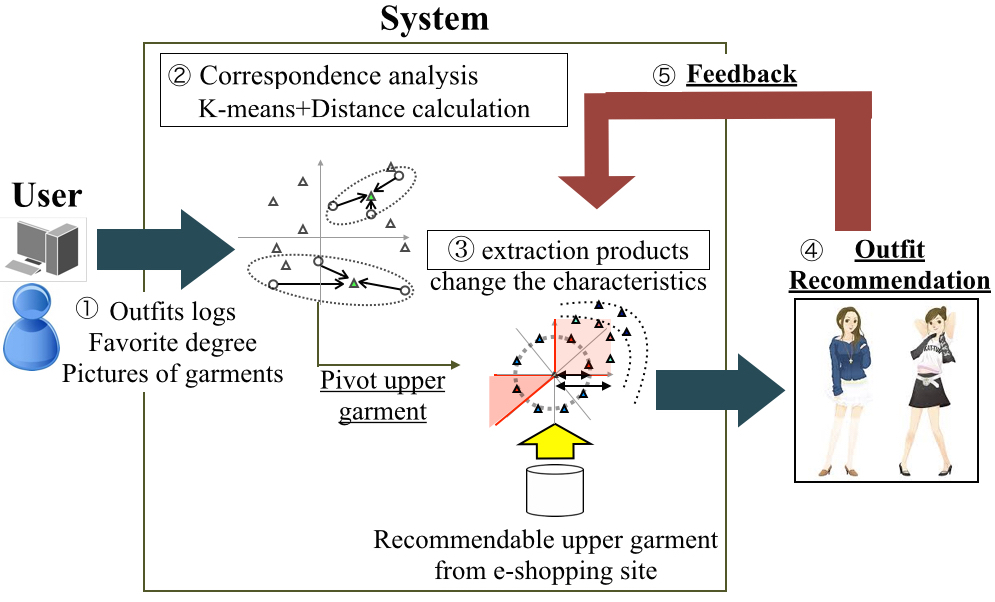 | Figure 2. Extract purchase candidate outfit |
First, a user registers pictures of their garments and logs of their outfits consisting of their garments. Frequent appearance of an upper garment together with a lower garment as an outfit in the logs reflects the favorite degree of users for the outfit.Next, a system applies the correspondence analysis and the k-means clustering to the outfit logs to divide her lower garments into clusters which are similar in the favorite degree from the view point of forming an outfit based on a specific upper garment. At the same time, a system extracts a pivot upper garment from each cluster.A system extracts a purchase candidate upper garment which holds characteristics slightly different from the pivot upper garment. It coordinates a purchase candidate upper garment with an accompanying lower garment as a purchase candidate outfit. The system recommends the purchase candidate outfits for the user. The system asks her how much she likes the recommended outfits as a feedback indicating her preference for them. The system repeats recommendation, modifying its recommendation way according to the user feedbacks.
3.3. Extraction of Pivot Upper Garment
The proposed method uses the outfit logs which reflected the favorite degree of users.To apply the correspondence analysis [9] [10] to garments a user registers, the system constructs a matrix, whose row represents each upper garment the user registers, while its column corresponds to each of registered lower garments. The system fills up each cell with the favorite degrees which varies from 1 to 5, where the greater the value, the larger the favorite degree. The favorite degree in each cell stands for the preference of the user for the combination of the upper garment and the lower garment, which corresponds to the row and the column of the cell, respectively. A cell takes a value from 1 to 5, if the user has formed an outfit with them. Otherwise, the system fills up the corresponding cell with 0. In the correspondence analysis, the system arranges both rows and columns so that cells of larger values make a line on the main diagonal of a new matrix obtained after the arrangement. It means the new matrix gives the maximum correlation over all cells in it.To make the explanation concise, let us focus on the favorite degree of lower garments used to form an outfit with a specific upper garment. The new matrix holds lower garments of high favorite degree in near columns, while those of low favorite degree or those appearing in no outfit log in far columns. Let us explain its meaning geometrically. If we plot each cell of the new matrix on a two-dimensional plane, lower garments frequently used to form an outfit with a common upper garment are located on near places. On the other hand, garments seldom or never used to form an outfit are plotted as points of a long distance.For each of the plotted points corresponding to outfits, the system makes clusters consisting of points locating nearby, applying the k-means clustering to all the point. The result of the clustering shows outfits clustered from the viewpoint of the use frequency in specific situations, which correspond to TPOs explained in section 3.1.Finally, in each cluster, a system extracts the upper garment which has the minimum sum of distance from all lower garments in the cluster as the pivot upper garment.Note the method explained above also holds in the case for upper garments used to form an outfit with a specific lower one.
3.4. Outfits Recommendation to Reflect User Feedback
The method recommends a user a purchase candidate outfit, which consists of a purchase candidate upper garment slightly different from a pivot upper garment and an accompanying lower garment frequently used together with the pivot upper garment.The method adopts the color of garments as an index to characterize them, because users usually value the color when they purchase garments. The method assumes the color of garments is represented with the two-dimension of the hue and the brightness based on the HSV color model [11]. The saturation is out of scope of the method, because people would give weight to the hue and the brightness more than the saturation when they judge the color of garments. In the HSV model, the hue ranges from 0 to 360, while the brightness ranges from 0 to 100.The system based on the proposed system analyzes the color of a pivot upper garment and the upper garment an e-shopping site prepares as the recommendation candidates. Here, upper garments to be candidate in the recommendation are referred to as recommendable upper garments. Through the analysis, the system recognizes the color of the widest areas of each garment in an RGB measure. The system regards it as the dominant color of the garment. If the widest area has a specific pattern composed of several color, the system adopts the most dominant color in the pattern.Next, the garment dominant color represented in the RGB measure is converted into one represented in the measure based on the hue and the brightness, using formulas in [11]. In addition, it is expressed as an index vector. The system treats the value pair | (1) |
as the two-dimensional index vector of the garment. In the conversion, the value of the brightness is multiplied by 3.6 so that the system can deal with brightness values by the same linear measure as hue values.The index vector of the pivot upper garment is subtracted from the index vector of each recommendable upper garment. The subtraction locates the pivot upper garment on the origin of the coordinate axes.Let us consider a circle of radius r which is calculated with | (2) |
Suppose coordinate plane (h,v) is divided into the area of s1 , … , s8 based on conditional expression from (3) to (10). | (3) |
 | (4) |
 | (5) |
 | (6) |
 | (7) |
 | (8) |
 | (9) |
 | (10) |
In the first recommendation, the system takes a specific initial radius value r0. The system finds the recommendable upper garment which is away from the origin of the coordinate axes by more than r0 but closest to the origin in each divided area. The system regards the recommendable upper garments as purchase candidate upper garments. The system combines each of the eight purchase candidate upper garments with an accompanying lower garment to form a default purchase candidate outfit, so that it can recommend each of them to the user.Each of the eight divided areas indicates a color direction the system propose the user to extend her preference. Default purchase candidate outfits use all of the eight divided areas, because the direction the user likes cannot be presumed at the first time. The user judges whether the extension is acceptable for each direction. The judgment is returned to the system as its feedback.If the upper garment in area si is accepted by the user, radius r is updated with r=r+δ. Calculating in the same way, the system recommends new combinations of purchase candidate upper garments with accompanying lower garments as default purchase candidate outfits. On the other hand, the system provides no recommendation for the area the user refuses, because it means she does not wish to extend the index vector into the direction.The system repeats recommendation until the user refuses an acceptance in all areas or is so satisfied with recommendation of outfits that she ends a system.
4. Experiments and Evaluation
4.1. Experimental Overview
To evaluate the validity of the proposed method, we must investigate the following two verification items.Purpose 1: Whether the proposed method can recommend the purchase candidate outfit or notThe proposed method enhances user purchase motivation, recommending the purchase candidate outfits. We investigate whether the proposed method can recommend garments which satisfy Conditions 1 and 2 (See Subsection 2.1).Purpose 2: Whether the purchase candidate outfits lead users to the purchase of users or notThis method assumes that the outfits satisfying Conditions 1 and 2 lead users to purchase. To confirm the assumption, we investigate whether users want to purchase them, if they are recommended to the purchase candidate outfits.There are 2 group of examinees of this experiment; one contains 32 Japanese women from 19 years old to 30’s, and the other consist of 32 Vietnamese women from 21 years old to 30’s.In this experiment, the examinees are recommended the purchase candidate outfits through the following steps. First, examinees register pictures of their upper garments and lower garments. They register about 10 garments for each. If there are outfit logs indicating every outfit they wear, the system automatically calculates how much they prefer each of the outfits from the frequency of its appearance in the outfit logs. To save the time, we avoid registering outfit logs. Instead, the examinees specify directly the favorite degree for each outfit with a value from 1 to 5. The system treats the data as outfit logs. For combinations of upper garment and lower garments they have never worn, the system sets their favorite degree as 0.The system based on the proposed method extracts the pivot upper garment using the registered information. The correspondence analysis is applied to calculate the distance between registered garments based on the favorite degree of each examinee. Once the distance is fixed, lower garments are divided into clusters with the k-means clustering. In the experiment, we apply the k-means clustering where k=3. This is because we have judged most women have 3 kinds of situations where they wear different outfits from our pilot study. For all upper garments in each cluster, the system calculates the sum of the distance from each lower garment in the cluster. It selects the upper garment which has the minimum sum as the pivot upper garment in the cluster.The system calculates index vectors value of recommendable upper garments to extract purchase candidate upper garment based on the procedure of section 3.2.We have used an e-shopping site, ZOZOTOWN [2], for the search of garments. We have acquired 100 pictures from each of 11 color categories (white, black, gray, brown, green, blue, purple, yellow, pink, red, orange) from the upper garment category of ladies at the e-shopping sites.The system extracts the recommendable upper garment which is closest to the origin of the coordinate axes in each 8 areas which is specified with the conditional expressions from (1) to (8) explained in section3.4 as a purchase candidate upper garment. When the system recommended them to the examinees, it combines each 8-purchase candidate upper garment with an accompanying lower garment as default purchase candidate outfits. The examinees answer whether they accept each default purchase candidate outfit. As it is explained in section 3.4, radius r is updated by r=r+δ in the area where a recommended outfit is accepted to repeat recommendation. The system repeats the recommendation until examinees return no acceptance in any area or they stop the system.In this experiment, default radius value r0 and step δ are fixed to 5.0, because most people feel the color is changed for the addition of 5.0 to the radian has been turned out to make most people feel the color changed in our pilot study.After the experiment, examinees answer a questionnaire to evaluate each of the presented outfits. First of all, recommended outfits must be accepted to an examinee. Let us consider only recommended outfits accepted by a specific examinee. The proposed method is proved to enhance her purchase motivation, if recommended outfits accord her own policy, they increase the variety of her outfits, and they incline her to purchase them. To confirm whether each of accepted purchase candidate outfits satisfies each of Conditions 1 and 2, and whether she wants to purchase it, the following evaluation questions are asked in the questionnaire.Question 1: Does this outfit match your preference?Question 2: If you buy this garment, does the variation of the outfit on hand increase?Question 3: Do you want to purchase this garment?All of evaluation questions are answered selecting one of “Strongly agree”, “Agree”, “Neutral”, “Disagree”, or “Strongly disagree” in the experiment in Vietnam, while they are evaluated by selecting either of “Yes” or “No” in the experiment in Japan. If the examinee answer is “No”, we ask her to state the reason. For an examinee who does not accept a specific outfit recommended by the method, we regard the examinee selects “Strongly disagree” (in the experiment in Vietnam) and “No” (in the experiment in Japan) in all of the three evaluation questions.
4.2. Evaluation Result
We show an experimental result by this method and an experimental result of an existing method [12].In existence method, first, a system finds garment types that the index value groups assemble among garments which user has. Next, this system extracts the index value group that is involved in the index value groups of one garment type but is not done in that of the other. Then, this system enhances user purchase motivation by recommending the garments that have the extracted index value group of users.A result of the experiment in Japan is expressed with “Proposed (J)”, a result of the experiment in Vietnam is expressed with “Proposed (V)”, and a result of experiment using an existence method is expressed with “Exist”. About Proposed (V), when an examinee answered “4” or “5” by each three question, we considered an examinee answered “Yes”.First, we validated Purpose 1. Figure 3 shows the cumulative frequency distribution which examinees answered, “Yes” for both question 1 and 2. Vertical axis indicates rate of people that is a result of each Proposed (J), Proposed (V), and Exist, and abscissa axis indicates the percentage of answering “Yes” for both question 1 and 2. The mean was 42% in Proposed (J) and 37% in Proposed (V). | Figure 3. Cumulative frequency distribution of the purchase candidate outfits recommendation |
Hence, the proposed method can recommend the purchase candidate outfits with the precision of about 40%.Next, we validated Purpose 2. Figure 4 shows the cumulative frequency distribution which examinees answered “Yes” for question 3 among the outfits with an answer by “Yes” in both question 1 and 2. This is the percentages of the outfit that the examinees want to purchase in the purchase candidate outfits recommended for them. A chart of Proposed (J) and Proposed (V) leans to the right side more than Existing in Figure 4. This thing shows that the proposed method recommends the high conversion rate outfits more than an existing method. The mean was 91% in Proposed (J) and 86% in Proposed (V). | Figure 4. Cumulative frequency distribution of outfits will lead to purchase |
If purchase candidate outfits are recommend, about 90% of them will lead to purchase. This result shows effectiveness of purchase candidate outfits in the recommendation of garments.Finally, we evaluated the proposed method totally. Figure 5 shows the cumulative frequency distribution that examinees answered, “Yes” for all three questions. The mean was 31% in Proposed (J) and 33% in Proposed (V). This is the percentages of the outfits that the examinees want to purchase in the purchase candidate outfits recommended for them.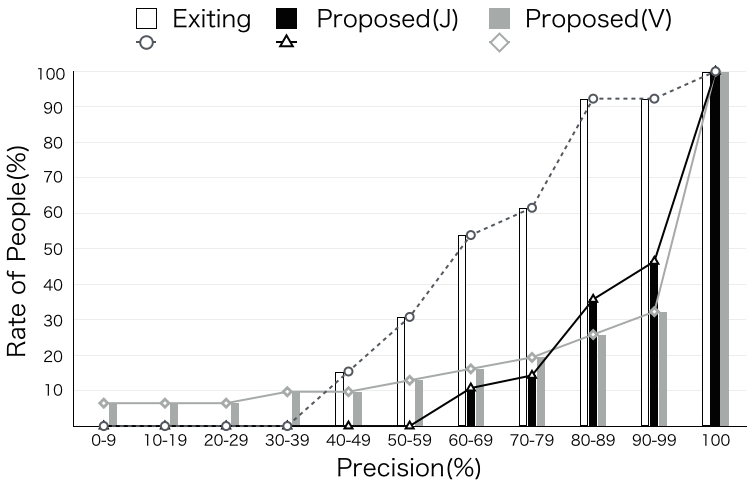 | Figure 5. Cumulative frequency distribution of the outfits that the examinees want to purchase |
On e-shopping sites that sell garments, the number of garments that are displayed per page is about from 15 to 20. Similarly, if this method recommends from 15 to 20 garments for a user, from 6 to 7 garments lead to purchase in the recommended garments. Consequently, the proposed method is useful to enhance user purchase motivation.
5. Discussion
5.1. Comparison with Existing Method
This proposed method improved an existing method [12]. The proposed method can recommend not only upper garment but also outfits that coordinate upper garment and lower garment.We think whether the recommendation precision of the existing method could be improved by this proposed method.First, we validated Purpose 1. From figure 3, it is recognized that most of Proposed (J) and Proposed (v) answered, ”Yes” for both question 1 and question 2 than Existing. Proposed (J) improves 10% and Proposed (V) improves 18% by a mean compared with an exiting method.This result shows that proposed method can recommend purchase candidate outfits by the high precision compared with an existing method.Next, we validated Purpose 2. From figure 4, it is recognized that most of Proposed (J) and Proposed (V) answered, ”Yes” for question 3 among the outfits with an answer by “ Yes ” in both question 1 and 2 than Existing. Proposed (J) improves 10% and Proposed (V) improves 18% by a mean compared with an exiting method.This result shows that the proposed method can recommend more garments leading to purchase than the existing method.Finally, we think about the overall recommendation precision of the proposed method. From figure 5, it is recognized that most of Proposed (J) and Proposed (V) answered, “Yes” for all three questions than Existing. Proposed (J) improves 12% and Proposed (V) improves 8% by a mean compared with an exiting method.This result shows that proposed method can recommend outfits satisfying conditions 1 and 2 (See Subsection 2.1) and leading to purchase than an existing method. Thus, the proposed method is more useful to enhance user purchase motivation than the existing method.
5.2. Improvement of Accuracy of Determining Purchase Candidate Outfits
Some examinees answered question1 by “No”. As that reason, the examinees answered, “I do not like the silhouette of the garment”, “I do not like the type of collar, or shapes of sleeves”, and “I do not like the pattern of the garment”.The proposed method does not consider the preferences of the partial shape and detail of garments such as silhouette, shapes of sleeves and patterns. Considering the preferences of the partial shape and detail of garments is needed to extract more accurate individual preferences.The addition of partial shape and detail of a garment as a new index can extract more accurate individual preferences. Therefore, recommendation accuracy of the purchase candidate outfits can be improved.Next, the some examinees answered, “The style of casual and formal is not suitable for upper garment and lower garment”, or “This does not match this jeans”.The proposed method does not consider the upper garment types and the correspondence of style of upper garment and lower garment. Combining the proposed method with an additional method which considers the outfit such as [2] can resolve the problem.
5.3. Difference in Age and Social Status
We have conducted the experiment to examinees of various ages and social status. From the viewpoints of age and social status, we examine what kind of consumers this technique is useful for.First, we consider the age of consumers. Figure 6 shows the cumulative frequency distribution of outfits getting positive answers for question 3 from examinees under 22 years old and from the elders. On the other hand, figure 7 shows that of outfits getting positive answers for all of the evaluation questions by examinees under 22 years old and elders. It is implied that most of the examinees under 22 years old answer "Yes" for questions from figure 6 and figure 7. The result shows outfits the proposed method recommends are more likely to be accepted by consumers younger than 23 than those elder or equal to 23.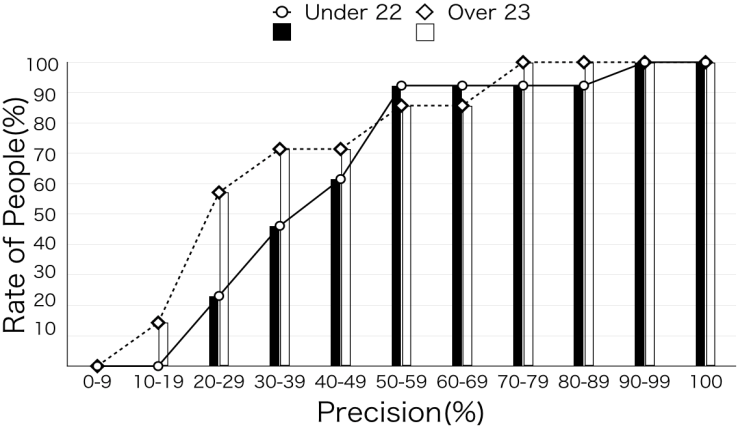 | Figure 6. Cumulative frequency distribution of outfits accepted in question in 2 age groups |
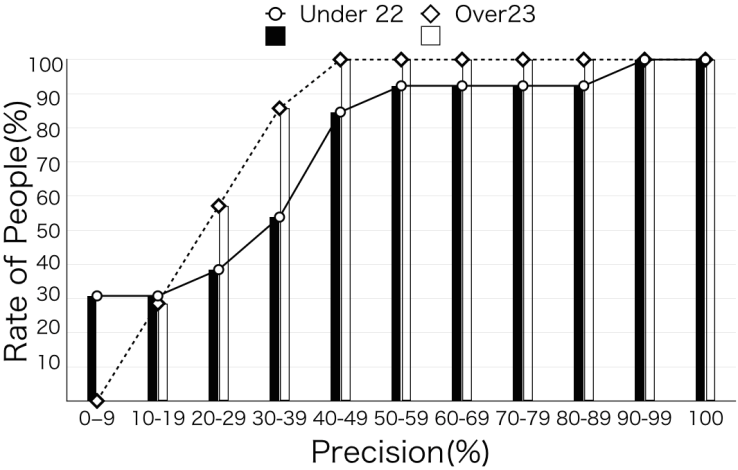 | Figure 7. Cumulative frequency distribution of outfits accepted in all questions in 2 age groups |
Next, let us consider difference of response of consumers for purchase candidate outfits from the viewpoints of social status. Figure 8 shows the cumulative frequency distribution of outfits getting positive answers for question 3 from student examinees and that from worker examinees. Figure 9 shows that of outfits getting positive answers for all of questions from student examinees and from worker examines. Figure 8 and figure 9 indicate that most of student examinees answer "Yes" for the questions. The result shows that the recommendation with the proposed method leads to the purchase in students more than in workers.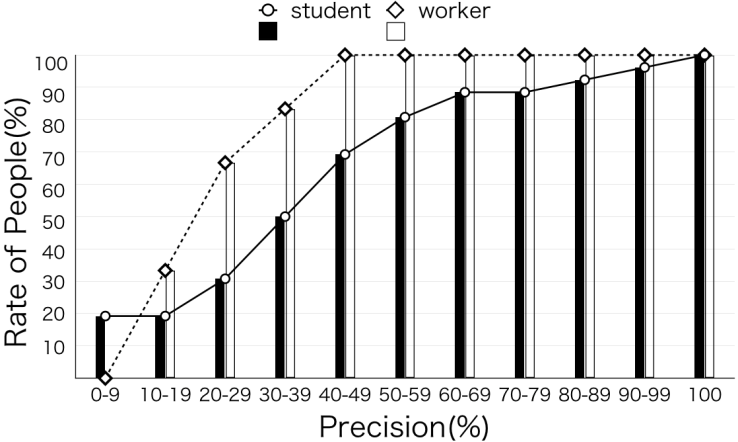 | Figure 8. Cumulative frequency distribution of outfits accepted in question 3 in 2 social status groups |
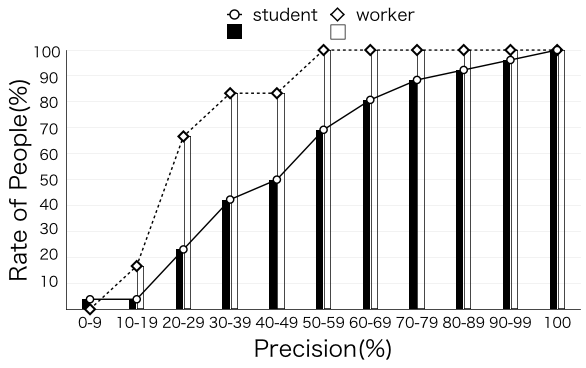 | Figure 9. Cumulative frequency distribution of outfits accepted in all questions in 2 social status groups |
Furthermore, it is supposed that the difference in Figure 7 and figure 8 is more conspicuous than that in figure 6 and figure 7. We can conclude the proposed method is suitable for younger consumers, especially for students.Here, we consider factors which make younger and student consumers to accept purchase candidate outfits. .All of outfit photographs in the experiment are picked up from Zozotown [2]. Zozotown sells garments for youths. It contributes to the high acceptance rate in younger generations. In addition, users purchasing outfits in e-shopping site are found more in younger generations including the student than in elder generations. Younger generations, especially student consumers accept more easily the method recommending outfits in e-shopping site more than elder generations. From the above, we can say that the proposed method is useful for the users of younger generation including students. In addition, the improvement of the acceptance rate of worker users is expected if we use photographs in e-shopping sites selling outfits for elders or workers.
5.4. Policy Extension in Color
The proposed method recommends new garments to enhance outfits of consumers based on their color, extending the policies of the consumers slightly. It recommends the same number of garments in all of the eight color areas. It is interesting to examine what area the examinees have accepted in the experiment.Table 1 shows the number of outfits the proposed method recommends, the number of outfits accepted by each examinee, and the acceptance rate in each of the eight areas. The rows correspond to the eight areas, while the columns represent the first recommendation, the second recommendation, the third recommendation, and the total results.Table 1. Recommendation result according to each divided eight areas
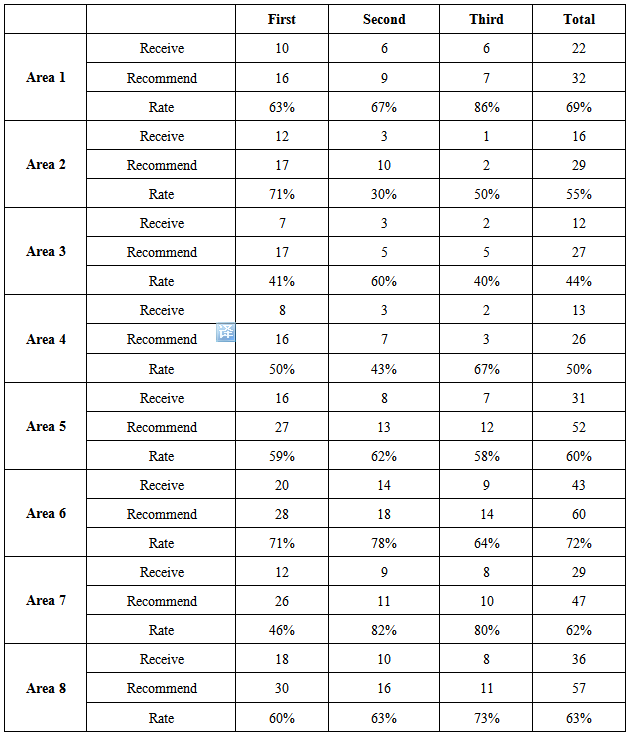 |
| |
|
Table 1 implies that the acceptance rate in area 1, 4, 7, and 8 increases as the number of the recommendation increases. On the other hand, it is supposed that the acceptance rate decreases in area 2 and 6 as the number of the recommendation increases.Referring to the example of the color in each of the eight areas depicted in figure 6, let us consider the tendency. As figure 6 shows, area 1, 4, 7, and 8 correspond to red close to purple, red close to yellow, blue, and purple, respectively. Table 1 indicates the recommendation to extend in these directions is well accepted. The extension means to light up red close to purple and red close to yellow in area 1 and 4, while to darken blue and purple in area 7 and 8. On the other hand, the extension of the direction in area 2 and 6 correspond to lighting up blue and darken green, respectively. The examinees have not accepted the extension well. Meanwhile, if we see the total results, dark green in area 6 and bright red close to bright purple in area 1 mark high acceptance rate. On the other hand, bright green of area 3 and bright yellow of area 4 mark poor acceptance rate. Considering a well accepted direction, we can improve the proposed method. The proposed method would be able to recommend a lot of outfits acceptable by users, giving higher weight on the directions marking better acceptance rate than that of poor acceptance rate.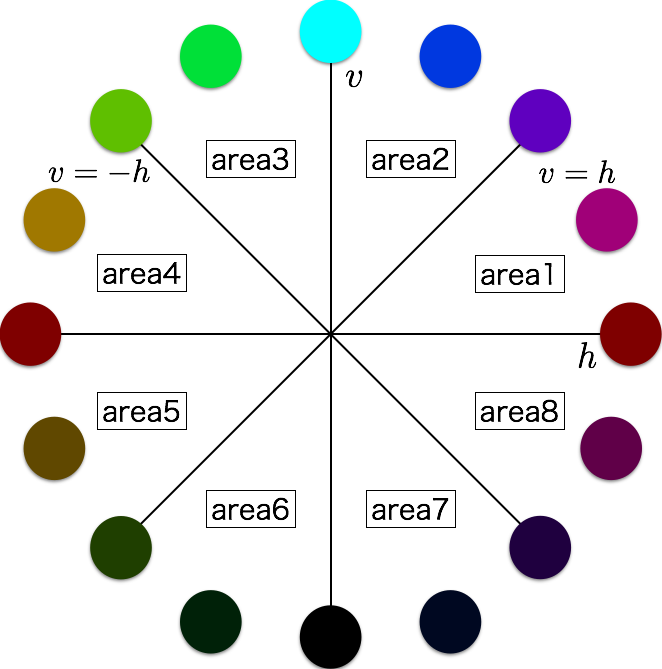 | Figure 10. Color in each area |
6. Conclusions
This paper proposed a method to recommend the purchase candidate outfit in order to support users to buy garment on e-shopping sites and enhance their purchase motivation. In this paper, we have proposed a method to recommend the garment which satisfies the following two requirements. The first requirement is to accord to user policies. The second is to lead users to change their images. In the proposed method, first, garments a user already has are divided into some clusters matching the preference of the user. The system extracts the upper garment that plays a pivot role. Next, the system finds an upper garment of little changed characteristics in the extracted upper garment, to coordinate it with the lower garment the user wear with the extracted upper garment as outfits. The system recommends these outfits for the user. The user gives the preference for those outfits as a feedback. The system repeats recommendation and receipt of user feedbacks. As the result, the system can recommend outfits which accord the policy of the user. It can increase the variety of available outfits for the user, which leads to the enhancement of her purchase motivation.From an experiment, it is proved that 90% of the recommended outfits matching the above requirements motivate the examinees to purchase them. In addition, this method has recommended purchase candidate outfits with 35% of the precision. It means, if this method recommends from 15 to 20 garments for a user, she is likely to purchase from 6 to 7 garments among the recommended garments.Future work aims at a comparison of the accuracy with other methods, attempting an evaluation of the usefulness of the proposed method.
References
| [1] | Nielsen. (2014) E-COMMERCE: EVOLUTION OR REVOLUTION IN THE FAST-MOVING CONSUMER GOODS WORLD? AUGUST 2014. [Online]. Available: http://ir.nielsen.com/files/doc_financials/Nielsen-Global-E-commerce-Report-August-2014.pdf. |
| [2] | ZOZOTOWN. [Online]. Available: http://zozo.jp. |
| [3] | MYHABIT. [Online]. Available: http://www.myhabit.com. |
| [4] | F. Harada, and H. Shimakawa, “Outfit recommendation with consideration of user policy and preference on layered combination of garments,” 2012, International Journal of Advanced Computer Science, vol2 (2), 49-55. |
| [5] | A. Sato, K. Watanabe, M. Yasumura and J. Rekimoto "suGATALOG: Fashion coordination system that supports users to choose everyday fashion with clothed pictures." Human-Computer Interaction. Towards Intelligent and Im plicit Interaction. Springer Berlin Heidelberg, 2013. 112-121. |
| [6] | T. Sekozawa, H. Mitsuhashi and Y. Ozawa, “One ‐to‐one recommendation system in apparel online shopping”, 2011 Electronics and Communications in Japan, 94.1, 51–60. |
| [7] | C. Huang, C. Wei, and Y. Wang, "Active learning based clothing image recommendation with implicit user preferences." Multimedia and Expo Workshops (ICMEW), 2013 IEEE International Conference on. IEEE, 1-4. |
| [8] | S.kim, “Integration of Environmental Contexts and Personal Factors for Coordinating Garments: An Environmental User Interface Paradigm to Enrich User Interactions,” 2009, ACM, Proceedings of the 47th Annual Southeast Regional Conference, 49-55. |
| [9] | Yelland, Phillip M. "An introduction to correspondence analysis." The Mathematica Journal 12 (2010): 1-23. |
| [10] | Nenadic, Oleg, and Michael Greenacre. "Correspondence analysis in R, with two-and three-dimensional graphics: The ca package." Journal of Statistical Software (2007). Vol. 20 (3), 1-13. |
| [11] | Chen, Wen, Yun Q. Shi, and Guorong Xuan. "Identifying computer graphics using HSV color model and statistical moments of characteristic functions." 2007, Multimedia and Expo, IEEE International Conference on. IEEE, 1123-1126. |
| [12] | T. Yoshida F. Harada and H. Shimakawa, “Recommendation for Garments Sales Promotion with Comparison of Multiple Features over Garment Types”, 2013, 12th International Conference on Telecommunications and Informatics (TELE-INFO '13), 270-276. |





















 Abstract
Abstract Reference
Reference Full-Text PDF
Full-Text PDF Full-text HTML
Full-text HTML